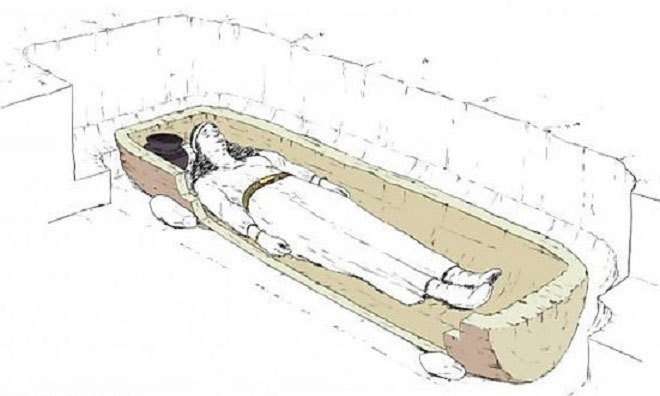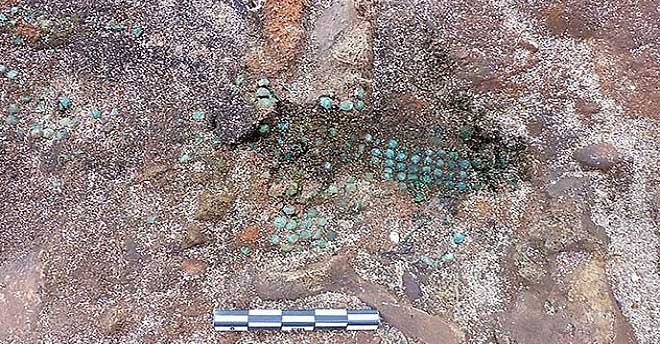Discovered 2,800 years' remains of an ancient princess
Archaeologists found the remains of an ancient princess wearing jewels made of green glass beads in an oak coffin.

Simulating the tomb of a woman 2,800 years ago. (Photo: INRAP).
The remains of a woman believed to be an ancient princess lay in a coffin with her arms propped down on her body. This person was buried in a rectangular pit measuring 2.9 x 1 meters, along with many jewels and ceramics placed near the head. A team of experts at the National Institute of Archeology (INRAP) discovered traces of the underground coffin and bones of a woman near the province of Saint-Vulbas, about 32 km from Lyon. This is one of 3 people buried in the area during the Stone Age in the 8th century BC.

Blue glass beads are used to make jewelry in the tomb. (Photo: INRAP).
According to archaeologists, each woman's wrist has a necklace decorated with green glass and copper beads. They also found a 5-cm-wide copper buckle, proving that the dead wore a belt, possibly made of leather. Fragments of the pelvis, thigh bone, part of the skull and sacrum also lay among the tomb objects.
Workers discover ancient cemeteries as they bulldoze to build the Plaine de L'Ain industrial park. People buried in the burial ground may come from the Halstatt culture , known for its intricate artefacts, cultivation and metalworking techniques in southeastern France. In 800 BC, many trade routes were set up to exchange copper, tin and iron, linking the region with the Mediterranean. This was also the time when hill fortresses appeared, including many walls and ditches to prevent hostile tribes.
- Gorgeous tattoos on Siberian princess body
- The treasure of 2600 years reveals secrets in Celtic princess graves
- Egypt discovered the tomb of a 3,700-year-old royal princess
- Discovering ancient tombs
- Found the remains of ancient people 3,500 years ago
- Discovered the ancient tomb of the 5th Pharaoh dynasty
- A woman's remains have been discovered for more than 3,500 years
- Rediscover the 6,500-year-old remains
- Detecting ancient human remains 1.8 million years in Indonesia
- Mexico studied 30 sets of ancient remains
- Dozens of remains in stone casket 1,600 years in Wales
- Found the ancient elephant remains that lived 3 million years ago
 Discovered an ancient centipede fossil 99 million years old
Discovered an ancient centipede fossil 99 million years old Discovered bat-like dinosaurs in China
Discovered bat-like dinosaurs in China Discovered a 200-year-old bronze cannon of the coast
Discovered a 200-year-old bronze cannon of the coast Discover 305 million-year-old spider fossils
Discover 305 million-year-old spider fossils Revealing the mystery of the woman who lived alone for nearly two decades on a deserted island
Revealing the mystery of the woman who lived alone for nearly two decades on a deserted island  When the world's tallest and shortest women meet
When the world's tallest and shortest women meet  Photos change the view of history
Photos change the view of history  'Rebirth of the vampire': The mystery of the brick-mouthed remains of the 16th century
'Rebirth of the vampire': The mystery of the brick-mouthed remains of the 16th century  World's oldest fake eye discovered
World's oldest fake eye discovered  The female explorers 'shocked' the history of world tourism
The female explorers 'shocked' the history of world tourism 